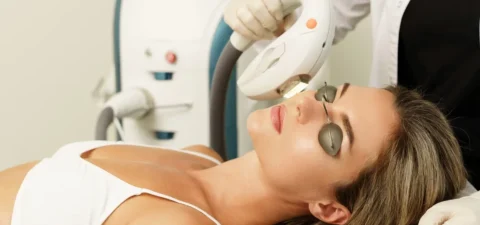For information only. Not meant as advice in any form. Please consult your medical professional or lawyer.
Starting a career in facial or medical esthetics is a rewarding and fulfilling journey. Aside from being able to help patients maintain their youthful and healthy skin, you’re able to maximize and enhance your skills as it offers a lot of opportunities for professional growth. If you’re interested in furthering your knowledge in skincare, becoming a master esthetician may be for you.
So what makes a master esthetician different from a standard esthetician? A master esthetician is an individual who has received advanced esthetics training to be able to provide a wider range of skin care treatments. They’re also skilled in using the latest technologies, such as non-ablative laser, radiofrequency energy, and intense pulsed light, for performing specialized skin procedures.
What Is A Master Esthetician: An Essential Guide
Anyone who’s passionate about taking care of people, offering solutions for cosmetic problems, and learning advanced skin care techniques can become a master esthetician. It’s one of the best professions you can take if you’ve completed your basic esthetics training program.
Master estheticians are basically advanced skincare professionals who have a wider understanding of different treatments and products that can help patients improve their skin health and appearance. They’re considered to be of a higher level than normal estheticians and can assist physicians or healthcare professionals to perform certain procedures.
What Does a Master Esthetician Do?
The roles and responsibilities of a master aesthetician aren’t that different from a regular esthetician. However, since they have more training and education in advanced anatomy and skin sciences, they can provide more specialized services to patients. Some of the usual tasks that a master esthetician does in a medical or clinical setting are:
- Performing skin analysis and diagnosis of clients’ conditions
- Recommending treatments to enhance skin health and appearance
- Administering basic facial services or skin care procedures
- Providing a lymphatic massage to eliminate toxins from the body and skin tissues
- Performing advanced chemical peel treatments for facial rejuvenation
- Using microdermabrasion techniques for skin exfoliation and resurfacing
- Using energy-based technologies for hair removal
- Providing holistic care for patients before and after their plastic surgery
- Using aromatherapy techniques for achieving cellular-level changes to the skin
What’s the Difference Between An Esthetician and A Master Esthetician?
One of the main differences between a regular licensed esthetician and a master esthetician is their level of experience and training. Not anyone who finishes esthetician school can immediately become a master esthetician. Generally, an esthetician license is one of the most basic accreditations any aspiring skin specialist can have, while a master esthetician certification requires finishing additional training hours and passing a state licensure exam.
Some of the other significant distinctions between an esthetician and a master esthetician are explained in the following table:
| Regular Esthetician | Master Esthetician | |
| Average number of training hours required | It varies per state but a standard esthetics training program can take anywhere from 200 to 1000 hours | In addition to the initial hours registered to complete esthetician training, you may need to complete around 500 to 600 additional hours of master esthetics program |
| Services they can provide | Chemical peels, facials, makeup application, lash extensions, brow services, waxing, acne treatments, spray tans, threading, body wraps, | Advanced chemical exfoliation, laser hair removal, radiofrequency treatments, intense pulsed light therapy, microdermabrasion, lymphatic massage, scalp massage |
| Salary outlook | $38,324 per year | $45,146 per year |
Where Can A Master Esthetician Work?
Regular licensed estheticians can be employed at beauty salons, day spas, and aesthetic wellness clinics. On the other hand, if you become a master esthetician, you can find work opportunities in different settings such as:
- Dermatology clinics
- Beauty spas
- Medical spas
- Health and wellness centers
- Plastic surgery facilities
- Tattoo removal centers
- Hospitals
- Specialty spas and salons
- Rehabilitation facilities
Common Questions About Becoming A Master Esthetician
Before you pursue master esthetician training, there are additional things you need to know. Becoming a master esthetician requires an investment of time and skills so you need to be thoroughly prepared. Here are some of the commonly asked questions about being a master esthetician:
1) What States Have Master Esthetician Licenses?
In most states, you can simply apply to upgrade your existing esthetician license to become a master esthetician. However, there are select states that require completing a master esthetician training course to qualify for licensure. Some of these states that offer master esthetician licenses are Oregon, Utah, Virginia, and Washington.
2) How Long Do You Have To Be An Esthetician To Apply For A Master Esthetician License?
If you want to acquire a master esthetician license, you can immediately pursue continuing education after finishing the standard medical esthetician training. Check with your practicing state if there are any required apprenticeship hours. Generally, a master esthetician needs to complete an average of 500 to 600 additional training hours to qualify for licensure.
3) How To Get A Master Esthetician License?
Interested individuals should have attended an esthetician school and finished their state’s mandatory number of training hours. Once you have your standard license, you can sign up for an esthetician apprenticeship or complete a master esthetician program. You’ll also need to pass several licensure exams before you can submit the application for a master esthetician license.
4) How Long Is The Master Esthetician Program?
This varies greatly per state requirements but a typical master esthetic program can take anywhere from 6 to 12 months to be completed. This includes hands-on training and advanced education on concepts and theories related to skin care.
Enhance Your Esthetician Skills With Aesthetic Training Courses From FACE Med Store
With the demand for skin care procedures continuously on the rise, master estheticians are one of the most needed professionals today. Having advanced esthetician training can greatly set you up for success in the field of facial aesthetics and bring you more opportunities to be one of the trusted experts for skin and beauty.
Supplement your master esthetician training with advanced online courses from FACE Med Store. We have a selection of online modules and training programs that can add to your aesthetic knowledge and enhance your esthetician skills. We also offer high-quality medical tools and supplies to help you perform successful procedures. Contact us today to know more about our courses and products.






